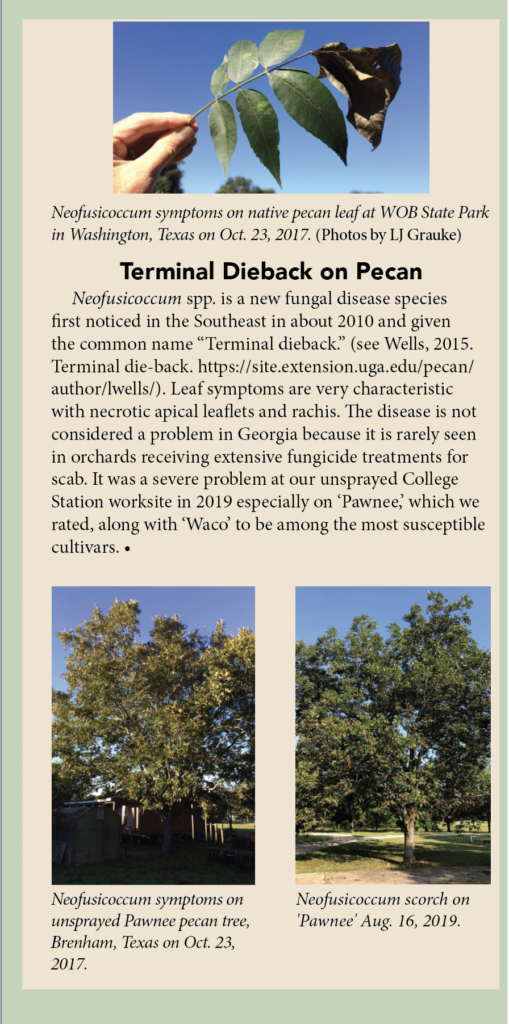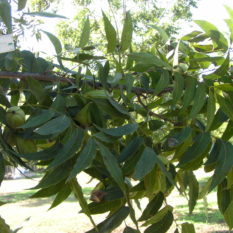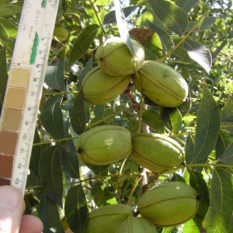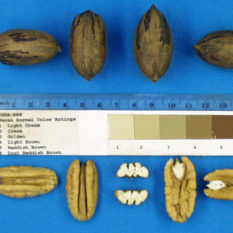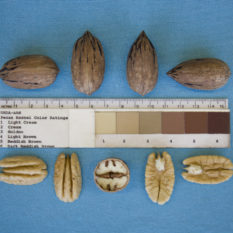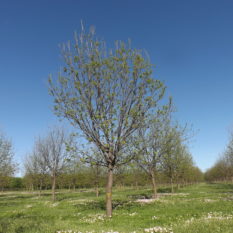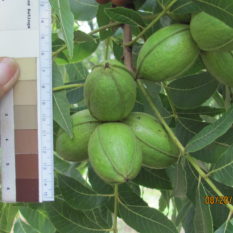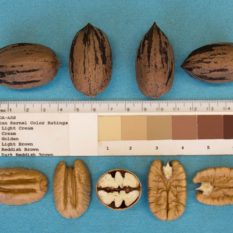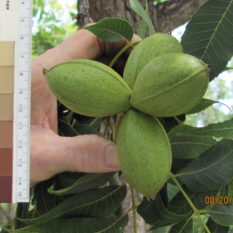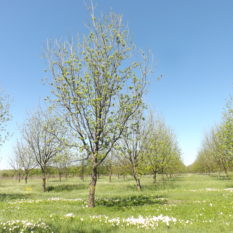Family Trees: The Next Generation
In his final article for Pecan South, Dr. LJ Grauke explains how researchers breed pecans and examines potential new releases.
The USDA-ARS Pecan Breeding & Genetics Program is at a transition point. In the past three Pecan South articles, we looked at the collection of living inventories that has grown from a “breeder’s collection” to represent global Carya populations, forming the National Collection of Genetic Resources for Pecans and Hickories (NCGR-Carya). Using that collection, cooperative research with national and international partners has developed genetic tools that will alter the process of selecting parents and progeny. Improved methods will alter breeding within this program and with others who have joined the breeding effort. To make the broad genetic diversity that is available in this collection available for breeding, it must be maintained and managed beyond the means of current staff.
Improvements in the pecan breeding process will include all of the players involved: the U.S. pecan industry who will determine what is an improvement; the research community that is developing the tools and techniques to find improvements; and USDA-ARS who maintains living collections and uses them for breeding (and for broad conservation purposes of international scope). Those three “armies” have independent goals and objectives. Getting them to move together toward a common goal requires agreement and communication. “Strategy” is defined as “a plan of action or policy designed to achieve a major or overall aim.” “Tactics” are the methods used to accomplish an end. This article’s purpose is to look at the previous methods (or tactics) used in pecan breeding, some of the stumbling blocks to delivering improved cultivars, and the possibilities for improvement in the future. Sun Tzu, a Chinese general in the fifth century B.C., noted that “Strategy without tactics is the slowest path to victory. Tactics without strategy is the noise before defeat.” For balance, we can remember the words of Dwight D. Eisenhower: “In preparing for battle, I have always found that plans are useless, but planning is indispensable.”
Historical methods of breeding pecans
Pecan cultivars released by this program (Table 1 in the September article) are the result of “controlled crosses.” The general process we have used for making controlled crosses in pecan was first described by Crane et al. (1937) and detailed by Grauke and Thompson (1996). Since pecan trees are large and bloom patterns vary between cultivars, tree lifts are necessary to reach catkins and clusters within canopies in order to monitor seasonal bloom closely, bag clusters at the right time, obtain viable pollen, and make crosses. The breeder protects the female parent’s pistillate flower clusters from wind-blown pollen by covering them with cellulose casing prior to receptivity. Catkins are collected from the pollen parent shortly before shed and allowed to dehisce on paper. Shed pollen is sieved through 100 mesh screens and refrigerated until use. Cooperative research with Gayle Volk (USDA-ARS National Center for Genetic Resource Preservation, Fort Collins, Colorado) has shown optimum humidity and temperature for long term storage, with pollen viability dropping swiftly in sub-optimal conditions. When pistillate flowers are receptive, pollen is loaded into a bulb syringe and aspirated through cotton at the base of the casing protecting the clusters. (see Making Controlled Crosses Figure 1 in the digital version of the magazine on page 38).
Developing nut clusters are protected from diseases and insects until they are mature, then harvested from the mother tree. Nuts are assigned a “cross number.” The convention of assigning cross numbers has been the same since 1931 when Louis Romberg initiated the system. USDA crosses might be distributed under various “nicknames” that obscure their identity (although genetic profiles can confirm them). It would be valuable for the pecan industry to understand and respect the nut’s current assigned cross numbers.
The first set of four numbers is the year the cross was made and the nut harvested from the mother tree. Until the late decades of the 20th century, only two digits were used for the year. We began using four digits as we approached the 21st century and realized that crosses might be made in 2031 that would carry the same numbers as Romberg’s early crosses.
The second set of two numbers represents the parents used for the cross. In his first cross in 1931, Romberg pollinated ‘Success’ flowers using ‘Halbert’ pollen. The female (nut) parent is listed first, and the male (pollen) parent second. In some years, there may be many parental combinations (up to 60 in 2010 when pollen viability tests were conducted). Still, two digits have always been enough to represent one year’s parent combinations.
The third set of four numbers represents the individual nut number assigned within that cross family. Only twelve nuts were harvested from Romberg’s first cross. Seedlings grown from those pollinations are in our records as 1931-01-0001 to 1931-01-0012. The greatest number of nuts from a single cross in one year was 3280, from the second cross family (‘Wichita’ x ‘Pawnee’) made in 1986. Those nuts were numbered 1986-02-0001 to 1986-02-3280 and planted to produce seedlings. The same parent combination was the fourth cross in 1989 from which 2357 nuts were harvested (1989-04-0001 to 1989-04-2357). As mentioned in the September Pecan South article, our nurseries have grown many ‘Wichita’ x ‘Pawnee’ seedlings.
Nuts are measured, weighed, stratified, and planted in a greenhouse where initial growth is monitored. For all crosses that I have made in the rootstock breeding program, numbered seedlings are transplanted to nursery sites where they continue to be monitored for years until the seedling blooms and bears. In the scion breeding program, Tommy Thompson (USDA-ARS, retired) initiated grafting tender buds from newly germinated controlled cross nuts into the tops of bearing trees to speed their development to maturity. That process requires great propagating skills as well as efficient tree-lifts. It complicates the process of subsequent seedling evaluations. When the controlled cross seedlings (or grafts) bear, nuts are harvested, destructively measured, and photographed. If seedling performance in the nursery and nut quality is appropriate, the seedling is selected for further evaluation.
Elite selections are grafted as entries in replicated tests of the National Pecan Advanced Clone Testing System (NPACTS). NPACTS orchards are given sequential alphabetic letters by worksite, while off-station tests are known by cooperator and location names. The maps of our worksites in the September issue of Pecan South showed NPACTS CSC and CSD at College Station (CSA and CSB are in the adjacent TAMU Storey Orchard managed by George Ray McEachern). The Brownwood worksite still maintains NPACTS BWA, BWB, BWC, BWD, and BWE orchards, all on City of Brownwood land currently managed by Pecan Grove Farms. All elite selections in external tests are propagated under a Material Transfer Agreement with cooperators, ensuring that distribution will only occur under the direction of the USDA Breeding Program. Microsatellite markers being used in NCGR-Carya have been adequate to confirm identity when controlled crosses are propagated under different names such as ‘Eclipse’ (=1963-16-0182, a ‘Mohawk’ x ‘Starking Hardy Giant’ progeny) and ‘Clark II’ (=1964-06-0233, a progeny of ‘Mahan’ x ‘Major’) (Grauke et al., 2015; Grauke, unpublished, respectively).
NPACTS orchards on our worksites have been monitored for growth by measuring trunk diameters (and occasionally height and canopy widths) in the dormant season, seasonal inception of budbreak and bloom, patterns of disease expression, crop load and cluster size, season of nut maturation, and individual tree yields. Nut samples from each tree are destructively measured for nut quality and photographed, linking an image to the measurements for each tree. The process is labor-intensive and has been impacted by the loss of workers. Due to water restrictions, we were unable to irrigate test orchards in Brownwood during the drought from 2012 to 2018. According to the U.S. Drought Monitor, the longest duration of drought in Texas lasted 271 weeks from May 2010 to July 2015.
The length of time from cross to release has increased under NPACTS (Table 1 in September 2019, Pecan South). Methods of testing selections before release must be improved so that tree performance is confirmed within geographic regions where they are grown under that region’s cultural systems. Ideally, the characteristics of selections based on available performance records (eventually including molecular markers) should be evaluated by regional teams that include growers and nursery producers to choose elite selections they wish to test further. Involved nurseries would receive graftwood of targeted selections for initial propagation and testing by involved growers.
Previous cultivar releases from the USDA Pecan Breeding Program have been public, with no patent protection. Such releases are mandated to be added to NCGR-Carya collections, making them immediately available for international distribution. Patenting elite selections in association with domestic distribution would delay international distribution. This delay could impact competition between producers because distributions of patented material would be made through licensing agreements, rather that requests of public material. It would also increase communication between regional growers whose cultivar needs may be as diverse as their cultural systems and the breeding teams developing the new selections.
The dynamic progress in developing genetic tools for pecan in the Specialty Crop Research Initiative grant (“Coordinated development of genetic tools for pecan”) will continue to associate genetic markers with measured tree performance. That process is made possible by the extensive nut quality records of NCGR-Carya, the Pecan Breeding Program, and test orchards such as NPACTS. Since the cultivars in NCGR-Carya are the parents of controlled cross progeny in the Breeding Program, the developing database is the genealogical record of our crop over its entire horticultural history.
The first opportunity for selection and further testing by regional growers will include controlled crosses that have been extensively tested but need to grow under targeted cultural systems and climate.
The following selections in this article are offered as examples.
1975-08-0005 (‘Osage’ x ‘Creek’)
1975-08-0005 is a cross between ‘Osage’ and ‘Creek’ made in 1975 by George Madden at USDA-ARS in Brownwood, Texas. The nut parent ‘Osage’ is a cross between ‘Major’ and ‘Evers’ made in 1948 by Louis Romberg at USDA-ARS in Brownwood, Texas. ‘Osage’ tends to be a compact tree that bears its small nuts heavily and matures them early. ‘Major’ is a native selection from the Green River in Kentucky that shows molecular evidence of hybridity with Carya cordiformis, or the bitternut hickory (Grauke et al., 2015). ‘Evers’ is a seedling selection that Romberg associated with very high precocity and used as a parent in ‘Cherokee,’ ‘Chickasaw,’ and ‘Shoshoni,’ all of which are very precocious and prolific with a tendency to alternate bear.
The pollen parent of 1975-08-0005 is ‘Creek,’ which was released as ‘Mohawk’ by ‘Starking Hardy Giant’ in 1996. However, its microsatellite profile is not consistent with that parentage. The microsatellite profile was consistent with ‘Mohawk’ x ‘Western’ as has been recently confirmed with genotyping by sequencing (Bentley et al., 2019). ‘Western’ obviously has something that works well in the West, and the connection of this selection to that cultivar may help get it tested in that area. 1975-08-005 was grown in a replicated NPACTS test in Burleson County that had six blocks with 35 entries occurring once per block. Ken Fangue also grew 1975-08-0005 and other selections at his orchard near Hempstead, Texas.

An example of the tree form of ‘1975-08-0005’ with a ‘Pawnee’ tree to the right. (Photo by LJ Grauke)
1975-08-0005 has very columnar growth, determined by dividing tree height by canopy width. It is in the top category for that measure, but so is ‘Pawnee.’ 1975-08-0005 is also in the smallest category for canopy volume, as is ‘Pawnee.’ Figure 1c shows 1975-08-0005 to the left of ‘Pawnee’ for comparison of form. Figure 1d shows how the crop is borne on shoots within the canopy. 1975-08-0005 averaged 2.2 nuts per cluster (compared to 3.3 for ‘Pawnee’). Concentrating crop in the central core of a columnar tree and distributing it among many medium-sized clusters may be an appropriate architecture for western orchards that are hedged and receive high light intensity. Increased tree density made possible by reduced tree size could significantly increase yields per acre.
Leaflet area shows a clinal trend at the forest level from largest in the northeast to smallest in the southwest, based on multiple years of data from provenance tests in Texas and Georgia (Grauke et al., 2003). Smaller leaflets may contribute to water use efficiency at the cultivar level but require testing. Without adequate canopy protection, trees could sunscald and be damaged or killed. Leaflet area (2 centimeters per leaflet) of 1975-08-0005 is significantly smaller than ‘Pawnee.’ Cultivar differences in transpiration based on leaf structure may be detectable using remote sensing with appropriate imaging systems.
1975-08-0005 is protandrous, with similar pollen shedding and receptivity to ‘Pawnee.’ Nut quality is generally good. In our test, the 6-year mean was 57 nuts per pound with 56 percent kernel (‘Pawnee’ averaged 50 nuts per pound with 59 percent kernel). During that period, which was the early age of the orchard, it bore more nuts (29.7 pounds per tree in the sixth leaf after grafting, compared to 18.2 for ‘Pawnee’). Nuts ripened on average on Sept. 19, compared to Sept. 16 for ‘Pawnee.’ When yield is expressed as pounds of kernel per square inch of trunk, 1975-08-0005 made 4.8 pounds per squared inch compared to ‘Pawnee’ at 3.6 pounds per squared inch.
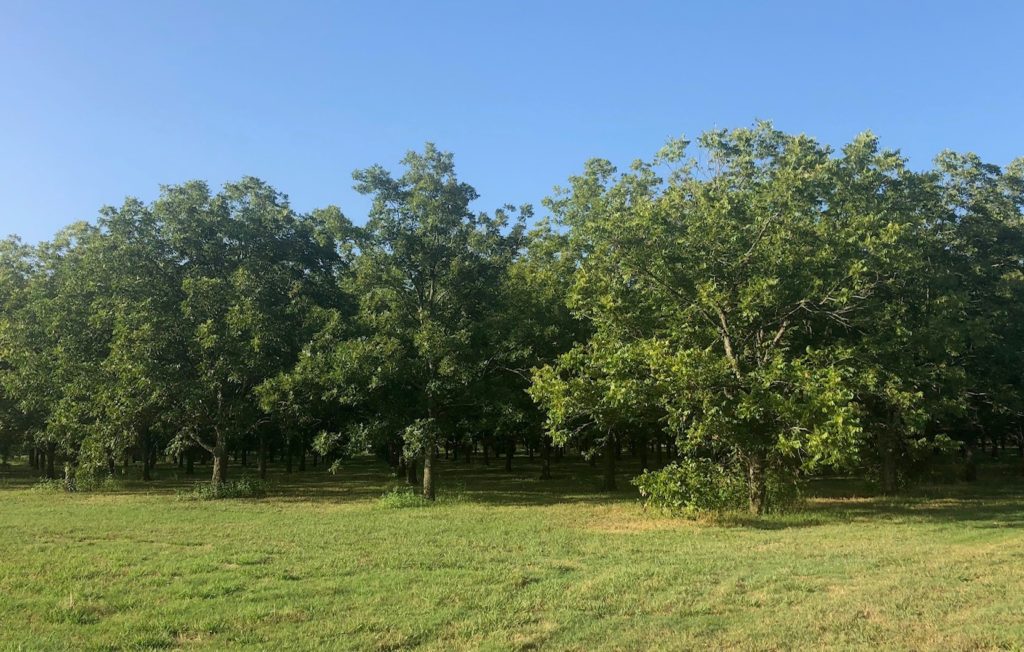
Another example of a tree form of ‘1975-08-0005’ in the center with a ‘Choctaw’ tree to the right. This photo was taken on Aug. 22, 2019. (Photo by LJ Grauke)
This selection has done well in our local tests and has also been tested by Dr. William Reid in (Kansas State University’s Pecan Experimental Field in Chetopa, Kansas) and by cooperators in Indiana. Leaf morphology and tree configuration suggest adaptations to the West, but tests are needed prior to making recommendations for that area. Cooperative grower tests in the Southeast might also be appropriate. Unfortunately, pecan bacterial leaf scorch has been confirmed in our trees of this selection with scorch symptoms observed. Active research is continuing to characterize PBLS in pecan. Distribution of graftwood from an undermanaged, stressed tree showing symptoms of PBLS would be irresponsible.
1997-34-0017 (NC-2B X NC-4)
1997-34-0017 is from NC-2B pistillate flowers pollinated using NC-4 pollen. This cross was made in 1997 by Lynn Johnson for Tommy E. Thompson at USDA-ARS in College Station, Texas. NC-2B and NC-4 are seedling selections obtained from Doug Campbell in Ontario, Canada. Genomic tests indicate NC-4 is a cross between ‘Colby,’ an Illinois native pecan, and ‘Peruque,’ a native pecan from Missouri. NC-2B is thought to be a ‘Colby’ seedling. This seedling was selected on the basis of very early nut maturation.
1997-34-0017 has a protandrous bloom pattern, like ‘Pawnee.’ It produces a compact, sturdy tree that is late to break bud in the spring and ceases growth early in the autumn, maintaining a determinate pattern of growth that should be freeze tolerant and do well in the northern region. Nuts have been high quality even under limited irrigation, with an 8-year mean of 65 nuts per pound with 57 percent kernel (‘Pawnee’ equals 50 nuts per pound, 59 percent kernel). Nuts ripen on average on Sept. 25 in Brownwood, Texas (Sept. 28 for ‘Pawnee’ in the same area).
The maximum amount of pecan scab (Venturia effusa) rated on shucks using standard area diagrams (SAD scale) (Yadav et al., 2013) has been 6 percent. ‘Pawnee’ and ‘Wichita’ were grown as controls and rated 91 percent in the unsprayed NPACTS BWE orchard. It would be valuable to use the molecular markers that have been developed by Noble Research Institute at this early stage of genomics work to see if they support the screening done in Texas, an environment with low scab pressure. Over time, markers will be developed for many traits and will facilitate the selection of both parents and progeny. Using them at this stage will engage the growers in the process and increase motivation for improvement.
1996-01-0295 (‘Pawnee’ X ‘Waco’)
1996-01-0295 results from a cross made on pistillate flowers of ‘Pawnee’ using ‘Waco’ pollen made in 1996 by Lynn Johnson for Tommy E. Thompson at USDA-ARS in College Station, Texas. The nut parent ‘Pawnee’ (released in 1984) is well known to the pecan industry for its early nut maturation, which was a primary target of the USDA Pecan Breeding Program under Thompson. ‘Pawnee’ resulted from a cross between ‘Mohawk’ and ‘Starking Hardy Giant.’ ‘Mohawk’ was released by Romberg in 1965 and is a progeny of ‘Success’ X ‘Mahan,’ two very prominent Eastern pecan seedling selections. ‘Starking Hardy Giant’ is a native pecan selected from Brunswick, Missouri.
The pollen parent of 1996-01-0295 is ‘Waco.’ ‘Waco’ is susceptible to pecan scab, limiting its use in southeast Texas except in orchards receiving fungicide. ‘Waco’ is a progeny of ‘Cheyenne’ X ‘Sioux.’ Like its nut parent, ‘Waco’ is at least moderately susceptible to the yellow aphid complex. Like its pollen parent ‘Sioux,’ it has large leaflets. Going farther up the family tree, ‘Cheyenne’ is a cross between ‘Clark’ (a Texas native from San Saba County) and ‘Odom.’ Genomic profiles show ‘Odom’ to be a progeny of ‘Russell’ and ‘Success,’ like ‘Desirable’ (Bentley et al., 2019).
1996-01-0295 was tested in NPACTS BWE Orchard in Brownwood, Texas, where irrigation is problematic. It has a protandrous bloom pattern like both of its parents. This selection makes large nuts with beautiful kernels (46 nuts per pound, 56 percent kernel in NPACTS BWE Orchard, Brownwood Texas, from 2009-2016). Harvest date is about Oct. 2 in Brownwood, (‘Pawnee’ Sep. 28; ‘Wichita’ Oct. 18).
The maximum scab on nuts is only 3 percent on the SAD scale of 1 to 100 percent, with ‘Pawnee’ and ‘Wichita’ at 91 percent in the unsprayed orchard. Again, profiling of this selection using genomic markers related to scab reaction would be valuable. 1996-01-0295 is a progeny of the two cultivars that are also rated most susceptible to an emerging fungal disease, Neofusicoccum spp., which is currently being described by Georgia pathologists.
The next generation
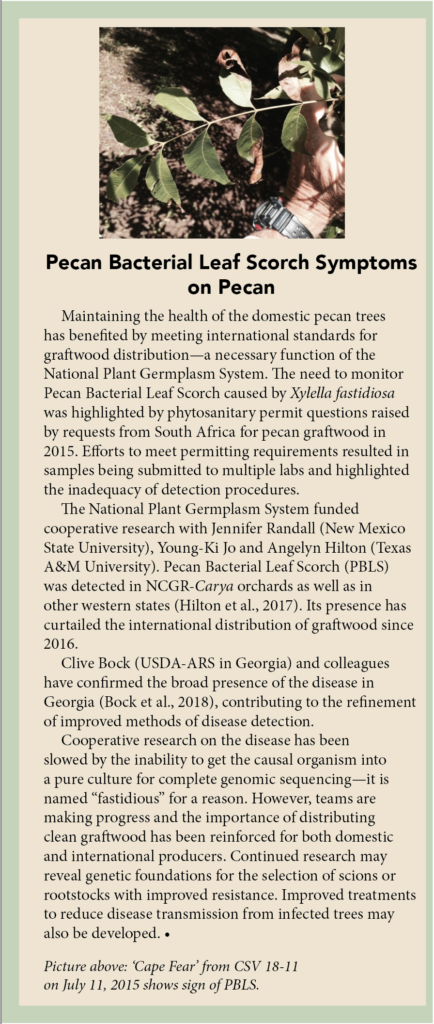 Genetic tools developed for pecan will progress to provide marker-assisted selection. Inclusion of controlled cross progenies currently growing in the Pecan Breeding Program’s nurseries established and evaluated biparental mapping populations to speed that effort. Inventory specific records of nut quality from the wide diversity of accessions in NCGR-Carya and Breeding Program planted have been measured over several years and will facilitate the development of markers associated with nut and kernel characteristics. Preliminary research has been done to screen variation in kernel lipid composition across the geographic range of pecan, along with diploid hickories, and interspecific hybrids. Nutrient value, as well as kernel palatability, may be amenable to genetic marker development. Shellers should be involved in delineating the optimum shape, shell structure, and kernel attributes for efficient shelling. The ability to identify morphological flaws such as tight dorsal grooves would allow recognition and eliminate genotypes carrying those markers, before the extended nursery time necessary for seedlings to bear. Selection of parents based on combined genotype/phenotype should increase progeny with desirable traits.
Genetic tools developed for pecan will progress to provide marker-assisted selection. Inclusion of controlled cross progenies currently growing in the Pecan Breeding Program’s nurseries established and evaluated biparental mapping populations to speed that effort. Inventory specific records of nut quality from the wide diversity of accessions in NCGR-Carya and Breeding Program planted have been measured over several years and will facilitate the development of markers associated with nut and kernel characteristics. Preliminary research has been done to screen variation in kernel lipid composition across the geographic range of pecan, along with diploid hickories, and interspecific hybrids. Nutrient value, as well as kernel palatability, may be amenable to genetic marker development. Shellers should be involved in delineating the optimum shape, shell structure, and kernel attributes for efficient shelling. The ability to identify morphological flaws such as tight dorsal grooves would allow recognition and eliminate genotypes carrying those markers, before the extended nursery time necessary for seedlings to bear. Selection of parents based on combined genotype/phenotype should increase progeny with desirable traits.
The detection of a quarantined bacterial disease, Xylella fastidiosa, in our orchards has focused research efforts to improve diagnostic methods to find reduced expression or genetic resistance in rootstocks and scions. Research is also seeking effective methods of remediation. While the quarantine prevents the distribution of graftwood, the distribution of selected seed from existing structured plantations (such as NPACTS orchards) provides an efficient way to distribute genetic diversity in open-pollinated nuts carrying high horticultural value. The currently available genetic tools allow us to determine pollen parent from open-pollinated seedlings grown from seed collected in orchards of known cultivars. Such diverse seedling nurseries would provide a safe alternative from which international cooperators could quickly select improved cultivars locally, while also maintaining nurseries as productive seedling stands. Nuts from NCGR-Carya accessions that descend from nuts originally collected in Mexico are adapted for use in tropical climates or temperate regions experiencing warming. Pecan plantations could be established in tropical as well as temperate regions for seedling culture rather than to graft into monocultures. We are currently discussing the selection of seedstocks to be sent to cooperators in Argentina for the establishment of long-term evaluation efforts. In order to develop and distribute high-quality nuts, existing orchards must receive improved management.
The genetic diversity revealed in natural populations across the geographic range of pecan suggests regional adaptations that deserve increased attention. Resolution provided by new genetic tools can facilitate the selection of regional rootstocks adapted to soils and climates, integrating the contribution of the microbiome to ecological adaptation (Cervantes et al., 2019).
Nuts for domestic forestry plantations might be selected from different parent populations, targeting regional adaptation, vigor, and tree structure while ignoring nut quality characteristics that drive horticultural selection. Such plantations were successfully established in the Red River Wildlife Management Area in Louisiana in 2003 and provide opportunities to use pecans as a landscape element for conservation purposes while observing progenies without the filter of chemical protection.
Cryopreservation of pollen from targeted inventories of NCGR-Carya (or Breeding Program accessions) provides a fast method for cooperators to make valuable crosses on their local trees to safely produce controlled cross progeny for their active participation in the breeding process. Pollen collections were made from several geographically and taxonomically diverse accessions and cryopreserved at USDA-ARS NCGRP in 2019. Continuation of that effort will require coordination and focus of resources if the demand justifies the effort. Genetic profiles of our controlled cross mapping populations revealed high error rates for some teams. The specialized labor and resources necessary for large numbers of controlled crosses using the techniques developed in 1937 may soon yield techniques for assembling selected cultivars in order to allow natural cross-pollination to produce high-value seed for continued selection.
There is much to do that will keep the next generation of pecan breeders productively engaged in conserving and using the genetic diversity available in NCGR-Carya. USDA-ARS programs in Texas and Georgia are treasuries of diversity held for long-term use on behalf of an ever-expanding, international clientele. Research teams must have access to those living collections and to the historic evaluation information related to them. National researchers must stay in close communication with each other and with the pecan industry in order to contribute to improvements that a diverse industry requires, currently being done well within the SCRI grant. International researchers have different objectives that will be addressed from the federal program within priorities that it must establish and support. Genetic diversity growing in well-documented test systems is the “hub;” high-quality research teams are the “spokes” that go in different directions to the local industries they serve, and the local pecan grower is where the rubber meets the road. Let’s roll!

